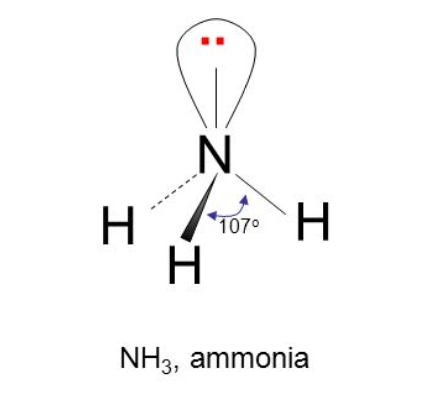
Why is the $H-O-H$ bond angle in ${{H}_{2}}O$ is smaller than the $H-N-H$ bond angle in $N{{H}_{3}}$?
Answer
574.8k+ views
Hint: The concept of intermixing of different atomic orbitals in which the energy is redistributed to give the new orbitals having symmetrical orientation in shape and equivalent energy of the orbitals. The new orbitals which are formed are known as the hybrid orbitals and this process is known as hybridization.
Complete step by step answer:
The theory which helps us to predict the shape and hybridization of the molecule is the valence shell electron pair repulsion theory or the VSEPR theory. Some important points of this theory:
The paired electrons which are present in the valence shell of the central atom is known as lone pair and the unpaired electrons form a bond with the unpaired electrons of other surrounding atoms known as bond pairs.
There are three types of repulsions in the molecule lone pair – lone pair repulsion, lone pair – bond pair repulsion and bond pair- bond pair repulsion.
The order of magnitude for the repulsive force is
Lone pair – lone pair is greater than lone pair- bond pair which is greater than bond pair –bond pair
Both water and ammonia molecules have $s{{p}^{3}}$ hybridization and the expected shape of both water and ammonia is tetrahedral.
Structure of $N{{H}_{3}}$

From the above structure
Number of lone pair=1
Number of bond pair=3
Structure of ${{H}_{2}}O$

From the above structure
Number of lone pair=2
Number of bond pair=2
Hence there is more lone pair – lone pair repulsion in water molecule as compare to ammonia, that’s why the$H-O-H$ bond angle in ${{H}_{2}}O$ is smaller than the $H-N-H$ bond angle in $N{{H}_{3}}$.
Note: One of the limitations of the VSEPR theory is that the bond angle deviation. This theory predicts molecular geometry but we cannot predict the shape of the transition metal compound using the VSEPR theory.
Complete step by step answer:
The theory which helps us to predict the shape and hybridization of the molecule is the valence shell electron pair repulsion theory or the VSEPR theory. Some important points of this theory:
The paired electrons which are present in the valence shell of the central atom is known as lone pair and the unpaired electrons form a bond with the unpaired electrons of other surrounding atoms known as bond pairs.
There are three types of repulsions in the molecule lone pair – lone pair repulsion, lone pair – bond pair repulsion and bond pair- bond pair repulsion.
The order of magnitude for the repulsive force is
Lone pair – lone pair is greater than lone pair- bond pair which is greater than bond pair –bond pair
Both water and ammonia molecules have $s{{p}^{3}}$ hybridization and the expected shape of both water and ammonia is tetrahedral.
Structure of $N{{H}_{3}}$

From the above structure
Number of lone pair=1
Number of bond pair=3
Structure of ${{H}_{2}}O$

From the above structure
Number of lone pair=2
Number of bond pair=2
Hence there is more lone pair – lone pair repulsion in water molecule as compare to ammonia, that’s why the$H-O-H$ bond angle in ${{H}_{2}}O$ is smaller than the $H-N-H$ bond angle in $N{{H}_{3}}$.
Note: One of the limitations of the VSEPR theory is that the bond angle deviation. This theory predicts molecular geometry but we cannot predict the shape of the transition metal compound using the VSEPR theory.
Recently Updated Pages
The number of solutions in x in 02pi for which sqrt class 12 maths CBSE

Write any two methods of preparation of phenol Give class 12 chemistry CBSE

Differentiate between action potential and resting class 12 biology CBSE

Two plane mirrors arranged at right angles to each class 12 physics CBSE

Which of the following molecules is are chiral A I class 12 chemistry CBSE

Name different types of neurons and give one function class 12 biology CBSE

Trending doubts
One Metric ton is equal to kg A 10000 B 1000 C 100 class 11 physics CBSE

What is 1s 2s 2p 3s 3p class 11 chemistry CBSE

Discuss the various forms of bacteria class 11 biology CBSE

State the laws of reflection of light

Explain zero factorial class 11 maths CBSE

An example of chemosynthetic bacteria is A E coli B class 11 biology CBSE




